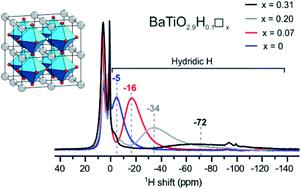Our official English website, www.x-mol.net, welcomes your feedback! (Note: you will need to create a separate account there.)
Trapping of different stages of BaTiO3 reduction with LiH
RSC Advances ( IF 3.9 ) Pub Date : 2020-9-24 , DOI: 10.1039/d0ra07276a Hua Guo 1 , Aleksander Jaworski 1 , Zili Ma 1, 2 , Adam Slabon 1 , Zoltan Bacsik 1 , Reji Nedumkandathil 1 , Ulrich Häussermann 1
RSC Advances ( IF 3.9 ) Pub Date : 2020-9-24 , DOI: 10.1039/d0ra07276a Hua Guo 1 , Aleksander Jaworski 1 , Zili Ma 1, 2 , Adam Slabon 1 , Zoltan Bacsik 1 , Reji Nedumkandathil 1 , Ulrich Häussermann 1
Affiliation

|
We investigated the hydride reduction of tetragonal BaTiO3 using LiH. The reactions employed molar H : BaTiO3 ratios of 1.2, 3, and 10 and variable temperatures up to 700 °C. The air-stable reduced products were characterized by powder X-ray diffraction (PXRD), scanning electron microscopy, thermogravimetric analysis (TGA), X-ray fluorescence (XRF), and 1H magic-angle spinning (MAS) NMR spectroscopy. Effective reduction, as indicated by the formation of dark blue to black colored, cubic-phased, products was observed at temperatures as low as 300 °C. The product obtained at 300 °C corresponded to oxyhydride BaTiO∼2.9H∼0.1, whereas reduction at higher temperatures resulted in simultaneous O defect formation, BaTiO2.9−xH0.1□x, and eventually – at temperatures above 450 °C – to samples void of hydridic H. Concomitantly, the particles of samples reduced at high temperatures (500–600 °C) display substantial surface alteration, which is interpreted as the formation of a TiOx(OH)y shell, and sintering. Diffuse reflectance UV-VIS spectroscopy shows broad absorption in the VIS-NIR region, which is indicative of the presence of n-type free charge carriers. The size of the intrinsic band gap (∼3.2 eV) appears only slightly altered. Mott–Schottky measurements confirm the n-type conductivity and reveal shifts of the conduction band edge in the LiH reduced samples. Thus LiH appears as a versatile reagent to produce various distinct forms of reduced BaTiO3 with tailored electronic properties.
中文翻译:

用 LiH 捕获不同阶段的 BaTiO3 还原
我们研究了使用 LiH对四方 BaTiO 3的氢化物还原。该反应采用 H ∶ BaTiO 3摩尔比为 1.2、3 和 10 以及高达 700 °C 的可变温度。通过粉末 X 射线衍射 (PXRD)、扫描电子显微镜、热重分析 (TGA)、X 射线荧光 (XRF) 和1 H 魔角旋转 (MAS) NMR 光谱对空气稳定的还原产物进行了表征。在低至 300 °C 的温度下观察到有效还原,如深蓝色至黑色立方相产物的形成所示。在 300 °C 下得到的产物对应于氢化物 BaTiO ∼2.9 H ∼0.1,而在较高温度下的还原导致同时形成 O 缺陷,BaTiO 2.9− x H 0.1 □ x,并最终在 450 °C 以上的温度下生成没有氢化 H 的样品。同时,样品的颗粒在高温下还原( 500–600 °C)显示出明显的表面变化,这被解释为形成 TiO x (OH) y壳和烧结。漫反射 UV-VIS 光谱在 VIS-NIR 区域显示出广泛的吸收,这表明存在 n 型自由电荷载流子。固有带隙的大小(~3.2 eV)似乎只有轻微的改变。Mott-Schottky 测量证实了 n 型电导率,并揭示了 LiH 还原样品中导带边缘的变化。因此,LiH 似乎是一种通用试剂,可生产各种不同形式的具有定制电子特性的还原 BaTiO 3 。
更新日期:2020-09-24
中文翻译:

用 LiH 捕获不同阶段的 BaTiO3 还原
我们研究了使用 LiH对四方 BaTiO 3的氢化物还原。该反应采用 H ∶ BaTiO 3摩尔比为 1.2、3 和 10 以及高达 700 °C 的可变温度。通过粉末 X 射线衍射 (PXRD)、扫描电子显微镜、热重分析 (TGA)、X 射线荧光 (XRF) 和1 H 魔角旋转 (MAS) NMR 光谱对空气稳定的还原产物进行了表征。在低至 300 °C 的温度下观察到有效还原,如深蓝色至黑色立方相产物的形成所示。在 300 °C 下得到的产物对应于氢化物 BaTiO ∼2.9 H ∼0.1,而在较高温度下的还原导致同时形成 O 缺陷,BaTiO 2.9− x H 0.1 □ x,并最终在 450 °C 以上的温度下生成没有氢化 H 的样品。同时,样品的颗粒在高温下还原( 500–600 °C)显示出明显的表面变化,这被解释为形成 TiO x (OH) y壳和烧结。漫反射 UV-VIS 光谱在 VIS-NIR 区域显示出广泛的吸收,这表明存在 n 型自由电荷载流子。固有带隙的大小(~3.2 eV)似乎只有轻微的改变。Mott-Schottky 测量证实了 n 型电导率,并揭示了 LiH 还原样品中导带边缘的变化。因此,LiH 似乎是一种通用试剂,可生产各种不同形式的具有定制电子特性的还原 BaTiO 3 。


























 京公网安备 11010802027423号
京公网安备 11010802027423号